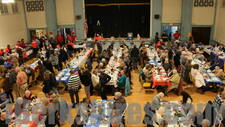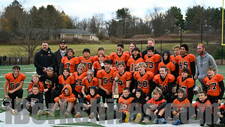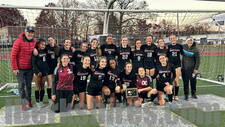Bytes from the Bean by Joe Manning 6-7-9912:00AM / Monday, June 07, 1999
"My father worked for Sprague thirty-five years. He worked at the Marshall Street plant. He had a little partitioned cubby hole instead of an office. I can remember walking down the dim, dark corridors on a weekend with him when he would go in to finish up some work, and then we'd go somewhere. The clock tower there is North Adams. I can't imagine North Adams without it. I go to church at St. Anthony's, and I am always looking at that tower. No one in their wildest dreams would have thought that plant would ever become an art museum."
Mark Rondeau, Editor of The Advocate
(Last year, The Advocate moved its offices into Building One at MASS MoCA.)
I attended the MASS MoCA preview for members on Friday and the grand opening on Sunday. My wife Carole and my daughter Ellen joined me for the preview. I was eager to show Ellen, who just graduated from Brandeis, why I was so enamored with North Adams. She hadn't been up since the David Byrne exhibit in 1996. I took her to my favorite spots: Eagle Street, Furnace Street, Hill Side Cemetery, the Sand Bank off River Street, and for a walk through the Little Tunnel. Within minutes, her fresh eyes saw many things I had never noticed.
Around the time of the Civil War, a man named Arnold started a cloth printing business in North Adams. People whose names have long been forgotten began putting up a series of brick buildings by the Hoosic River on Marshall Street, buildings that would have been considered unremarkable in their time. After all, they were just like the cotton mills that sat along the Merrimac River north of Boston and in many other New England communities.
At the same time, Irish immigrants were experimenting with nitroglycerine, as they attempted to blast a train tunnel through the mountains east of North Adams. Twenty-five years earlier, a "crazy idea" was proposed by western Massachusetts politicians and business leaders. They wanted trains running from Boston to Albany and Chicago to come through the northern Berkshires instead of through Springfield. Had they known at the time that it would take a generation of frustrating battles to secure the blessings of the Commonwealth, the five-mile long Hoosac Tunnel might never have been built. It must have been a happy day for Mr. Arnold when the first train pulled in just south of his factory 125 years ago. In the years ahead, Arnold Print Works would become the largest company if its kind in the world.
Around the turn of the century, a man named Marconi had another "crazy idea." In 1920, KDKA in Pittsburgh went on the air and reported the election of President Warren G.Harding. In a short time, American families would gather in their living rooms every night to listen to the radio. A brilliant young man named Sprague from Quincy, Massachusetts, must have been listening. too. A few years later, he invented a little gizmo for radios called a condenser (later called a capacitor), which controls the tone. He moved to North Adams, where he made them in his basement. He went door to door selling shares of stock and soon had a small company.
When World War II broke out, Sprague was on his way up, and Arnold was on the way down. Unable to convert to the production of military clothing, Arnold Print Works all but went under, and Sprague Electric moved in to the Marshall Street buildings. Spurred on by government defense contracts, Sprague grew incrementally and had nearly 4000 employees by 1966. When foreign competition and other factors closed the factory in 1985, Mr. Arnold's twenty-eight buildings on Marshall Street were left to sit empty and dusty, with only the sound of the river and an occasional train breaking the silence. Not even the clock tower rang anymore.
As I was leaving the grand opening, a little boy and his father were entering through the gate.
Boy: What are those trees doing?
Father: They planted them upside down.
Boy: Why?
The grand opening of MASS MoCA will prove to be the most important event in North Adams since the opening of the Hoosac Tunnel. It represents a spiritual awakening. The education of our young citizens will take a sharp turn in the next few years. The arts environment created by the museum and its events will stimulate children to learn about and participate in all of the arts. North Adams will become known for producing artists, actors, writers, dancers, and film makers. MoCA will not only create a suitable space for existing art that has not been shown, it will create a whole new art form. Artists will be inspired by the large and unique gallery spaces, the surrounding mountains, and the mill town history of this beautiful city.
For more than 125 years, the mills at 87 Marshall were run by major companies that virtually "owned" North Adams. Arnold and Sprague set the standards for wages and working conditions. The clock tower told people when to get up, when to eat lunch, and when to go home. Because MASS MoCA is a non-profit organization supported mostly by tax dollars and donations, it belongs to "US," not to "THEM." In many ways, it is like a public park. When I look at MASS MoCA, I don't see just a museum, I see North Adams. When the clock tower tolls, it tolls for North Adams.
I owe a lot to those forgotten people who built the beautiful buildings that are now an art museum. I heard about MASS MoCA in July of 1996 and made my first visit to North Adams. In less than two months, I was writing poetry, interviewing old-timers, and taking lots and lots of photos. MASS MoCA brought me to North Adams, but the city and its people brought me back.
Why do I come here so often? What's so special and unique about North Adams? In many ways, it is not unique at all. Like most northeastern industrial cities and towns, North Adams is a community of immigrants. Most of its ancestors worked hard for low wages, had lots of children, and had deep and conservative religious traditions. Hard times and hard winters line the faces of our Yankee ancestors in the old black and white photographs we discover in libraries, museums, and family albums.
But North Adams is unique. The geographical setting not only makes North Adams haunting and strangely beautiful, but it is partly responsible for the personality of its inhabitants. The surrounding mountains have created a perception of isolation which has influenced many generations of people to look inward, to depend on closeness, and to value their extended families and neighbors.
This perceived isolation has resulted in a culture that has, to a great extent, resisted the forces of social change that have swept this country since World War II. I am reminded of Smith Island, a Southern Maryland community fifteen miles offshore in the Chesapeake Bay. Little has changed there in two hundred years. The watermen speak in a dialect that few other Maryland citizens can understand. North Adams is not an island, but people are different here. They are old fashioned in a most endearing sort of way.
I often tell people that I would like to live in a town where people don't want to drive out of the city on the highway, they want to walk into the city on its streets and sidewalks. If you have attended the Downtown Celebrations the past three years, you know that thousands of people strolled into the city from the hills. That's because much of the population lives within walking distance of downtown. I love to stand in the parking lot on the south side of Main Street and stare at all the houses looking down and the streets winding their way into town. It gives me a feeling of belonging that I have not experienced elsewhere.
North Adams has a profound sense of community that derives from the shared socio-economic status of most of its citizens over a period of more than one hundred years. From the cotton mills to Arnold Print Works to Sprague Electric, families of many nationalities and religions have been brought together by a common struggle. Even today, this generous city is blessed with an astonishing number of social agencies and hundreds of caring volunteers, old and young, who expend time and energy in behalf of their fellow citizens without a second thought.
When I started writing Steeples, I made a conscious effort to photograph just about everything I saw. I did not limit my subjects to familiar landscapes and landmarks and things of obvious beauty. I still do that. On every visit, I discover something new and interesting. After all, North Adams is a collection of things that reflect our diverse ethnic and religious heritages, our various economic groups, our commerce, and the limitations of our landscape. I don't want to miss anything.
Visit Joe's website at: www.sevensteeples.com.
Email Joe at: manningfamily@rcn.com. |


















